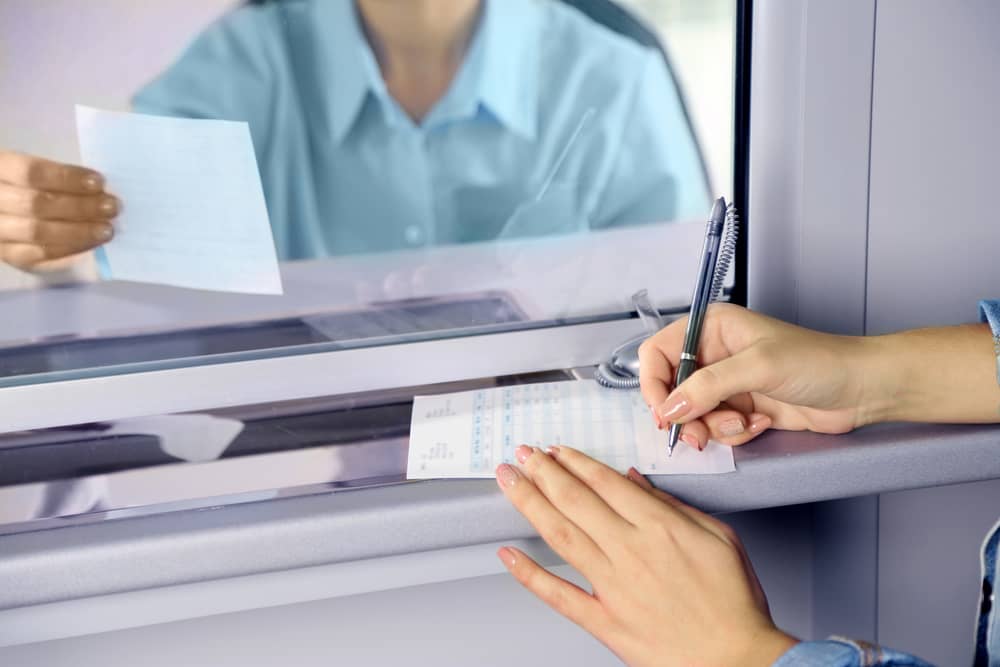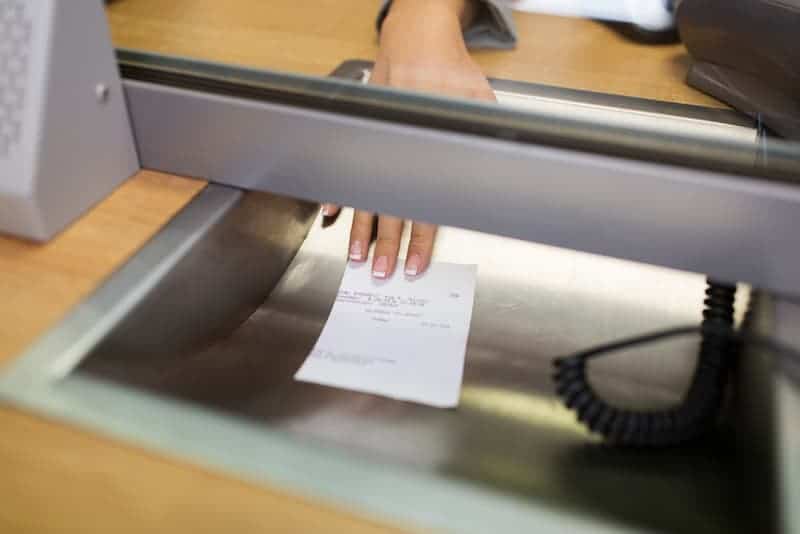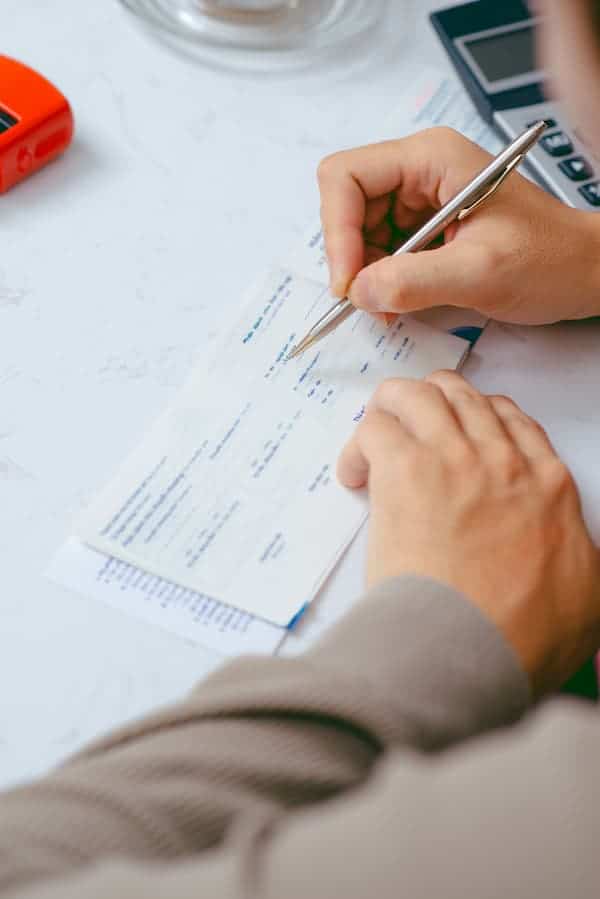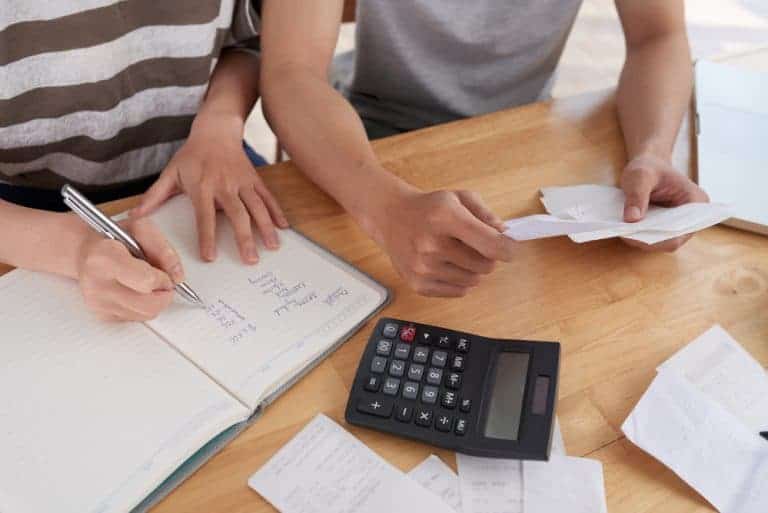Can I deposit a check for someone else? This is a question that many people ask when they find themselves in a situation where a friend or family member needs to deposit a check but they’re not available to deposit it themselves, so they ask you to do it for them.
So can someone else do this for them? Well, the answer is – like so many of these sorts of things – it depends.
In this article, we’ll show you exactly when (and how!) you can do this and provide some tips on what to do if you find yourself in this situation.

Can I deposit a check for someone else?
Technically, yes, you may be able to deposit a check for someone else into your own bank account. Make sure that they endorse the check and talk with the bank to see what specific steps they require you to take. Most likely, they will need to write “pay to the order of” followed by your name for validity.
If you’re trying to deposit someone else’s check into their own bank account, you’ll need to talk to the bank to see what their specific requirements are. In general, most banks will require the check writer to be present in order for them to deposit the check into their account.
There are a few reasons why banks have this requirement in place. The first reason is that it helps to prevent fraud. By requiring the check writer to be present, the bank can confirm that the check is legitimate and that the person who wrote the check has not been deceived in any way.
Related: Can Someone Else Deposit a Check For Me?
The second reason is that it helps to prevent mistakes. If you were to deposit someone else’s check into your own account, there is a chance that you could make a mistake and deposit the wrong amount of money. By requiring the check writer to be present, the bank can confirm that you are depositing the correct amount of money.
If you find yourself in a situation where you need to deposit someone else’s check but the person who wrote the check is not available, there are a few options that you can consider.
Can I deposit a check for someone else into their account online?
The only way to deposit a check into someone else’s account is by having that person give you their online credentials in order to access their account. Once you have their login information, you can access their account and deposit the check.
If your name is also on the account, you should have access and be able to deposit the check as well.
FYI: One issue with logging into another person’s account, assuming you have permission, is that there is often a 2-step authentication process in place. This could present a challenge if the account owner is not available to receive the code needed to log in.
If the individual you wanted to deposit a check for hasn’t provided you with their login information, then you can’t deposit the check. It’s illegal to source their login information any other way since it isn’t consensual. You’ll have to wait until they’re available or find another way to deposit the check.
Can I mobile deposit someone else’s check?
A mobile check deposit, much like online deposits, requires the account owner’s login information. Once you have that, follow the instructions on your bank’s app to deposit the check. If you don’t have access to the account owner’s login information and they can’t or aren’t available to provide it, then you won’t be able to mobile deposit the check.
Similarly to online deposits, if you are the co-owner of the account, you should be able to log in and deposit the check. The same challenges with two-step authentication may apply if the account owner isn’t available to provide the code needed to log in.
Mobile deposits are becoming increasingly popular, but there are still some banks that don’t offer this service. If your bank doesn’t offer mobile deposits, then you’ll need to visit a physical branch in order to deposit the check.

How to deposit a check for someone else
1. Get permission to deposit the check
The first and most important step is to get permission from the check writer. This ensures that they are aware of what you’re doing and that they consent to you depositing the check into their account.
If the check writer is not available or if they are unable to give you their permission, then you will not be able to deposit the check.
You may also be interested in:
- How to Write a Check: A Simple Step-by-Step Guide
- Can You Use White Out If You Make a Mistake on a Check?
2. Contact the bank beforehand
If you plan on depositing the check in person at the bank, it’s important to know what is needed to properly deposit the check. Each bank has its own policies and procedures in place, so it’s best to contact your bank beforehand.

Some banks may require that you have a power of attorney in order to deposit the check on someone else’s behalf. Others may require that the person who wrote the check is present when you make the deposit.
If you’re not able to get in touch with your bank or if you’re not sure what their policies are, then it’s best to err on the side of caution and bring the account bearer with you when you make the deposit.
3. Get login information
If you’re depositing the check online or through a mobile app, then you’ll need the account owner’s login information in order to access their account.
Make sure that you have this information before trying to deposit the check. If you don’t have the login information and the account owner isn’t available to provide it, then you won’t be able to deposit the check.
Keep in mind that 2-step authentication may be in place for online and mobile deposits. This means that you’ll need the account owner’s permission to log in as well as a code that is sent to them in order to complete the login process.
4. Get the bank account number
In order to deposit the check in person, you’ll need the account number and the full name of the account owner to get started.
This information is typically found at the bottom of the check. If you’re unsure of which account to deposit the check into, then you can ask the account owner or contact your bank for more information.

5. Sign the back of the check
Once you have the check and the necessary information, the next step is to sign the back of the check. This is a standard procedure for all check deposits.
If you’re depositing the check online, there may be specific requirements for how you sign the check. For example, some banks require that you write “For Mobile Deposit Only” or include your initials.
It’s best to have the account holder sign the check before you deposit it. This way, you can be sure that the signature is valid and that there won’t be any issues with the deposit.
Related: What is a Certified Check – and How Do I Get One?
6. Cash or deposit the check
The last step is to either cash or deposit the check. If you’re cashing the check, then you’ll need to bring it to a physical bank location and exchange it for cash.
If you’re depositing the check, you can do so online, through a mobile app, or in person at a bank branch. Each method has its own requirements, so be sure to follow the instructions from your bank.
Can I deposit someone else’s check in my account?
Yes, you can deposit someone else’s check into your account as long as you have the proper documentation and the bank approves it. You will need to get permission from the check writer and may need additional documentation like a power of attorney or to have the person present when making the deposit.
As always, it’s best to reach out to the bank beforehand to see what their specific policies and procedures are. The original check recipient will likely have to sign the check over to you, which is a way of releasing liability for the funds being transferred. This also allows you to cash or deposit the check into your account.

Can I deposit my daughters’ check into my account?
If your daughter is a minor, then you may be able to deposit her check into your account. However, this will likely require additional documentation and approval from the bank. It’s best to contact your bank beforehand to see what their policies are.
You may need to provide proof of guardianship or have the check written out specifically to you in order for it to be deposited into your account.
If the bank does allow you to deposit your daughter’s check into your account, then you’ll need to sign it on your daughter’s behalf and also note the words “minor” or “parent” on the back, depending on the bank’s specific policies.
Putting your child’s name on your bank account can make it easier to manage their finances, but it’s important to consider the risks before making this decision.
On one hand, it’s an excellent way for your daughter to learn about money and how to manage her finances. On the other hand, it could create problems if the guardian doesn’t appropriately monitor the account and its usage.
You may also be interested in: Can I Use a Check With an Old Address?
Can I deposit a check for my husband?
Like all other scenarios, this depends on your specific bank or credit union. Usually, in order to deposit the check on your husband’s behalf, you would need him to endorse the back of the check and write “pay to the order of [your name].”
That way, when you go to deposit the check, you would include your own identification and sign the back of the check as usual.
You may also need to provide additional documentation proving that you are authorized to sign on his behalf. This could include a power of attorney or a similar document.

Once again, it’s always best to check with your bank beforehand to see what their policies are. Your husband may need to be present when depositing the check or may need to provide specific documentation.
Many couples share joint bank accounts, which makes it easier to manage their finances together. If you don’t have a joint bank account, then depositing your husband’s check into your account may be the best option.
Can you deposit someone else’s check in your account ATM?
It’s generally not a good idea to deposit someone else’s check into your account at an ATM. This is because many banks will require specific documentation in order for the deposit to go through, which can’t be verified when using an automated machine.
It’s best to check with your bank beforehand to see if this is an option. It may be easier and more straightforward to have the account owner cash the check for you rather than use the ATM, or try to deposit the check in person or online for them where a live teller can help you.
You may also be interested in: Is It Safe to Order Checks Online?
What is considered a third-party check?
A third-party check is a check that is made out to someone other than the account holder. In order for a third-party check to be deposited, it usually needs to be endorsed by the person who the check is made out to on the back of the financial note.
Cashier’s checks and money orders may also be called a third-party check. Some examples of a third-party check are if you need to deposit a check that’s made out to your business partner or pay rent with a personal check but the landlord doesn’t have an account with your bank.
It’s important to know that there may be additional requirements and fees when depositing a third-party check, so it’s always best to check with your bank beforehand.
Do all banks accept 3rd party checks?
Not all banks accept third-party checks. Each bank has its own specific policies, so it’s always best to check with your bank beforehand. Some factors that may affect whether or not your bank accepts third-party checks include the amount of the check, the relationship between the account holder and the payee, and whether or not proper documentation is provided.
In general, it’s always best to deposit a check directly into the account of the person it’s made out to. This will ensure that there are no problems with the deposit and that it goes through without any issues.





